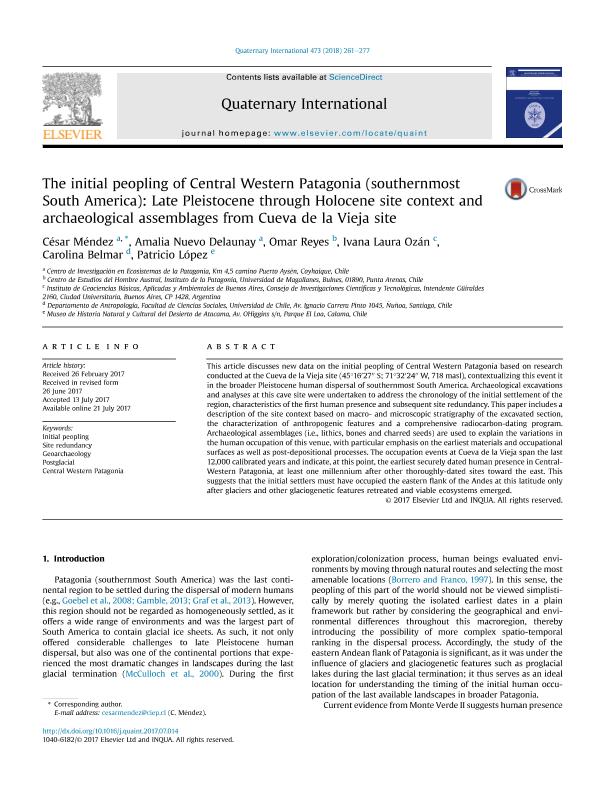Mostrar el registro sencillo del ítem
dc.contributor.author
Méndez, César
dc.contributor.author
Nuevo Delaunay, Amalia

dc.contributor.author
Reyes, Omar
dc.contributor.author
Ozán, Ivana Laura

dc.contributor.author
Belmar, Carolina
dc.contributor.author
López, Patricio
dc.date.available
2019-10-30T20:34:33Z
dc.date.issued
2018-04
dc.identifier.citation
Méndez, César; Nuevo Delaunay, Amalia; Reyes, Omar; Ozán, Ivana Laura; Belmar, Carolina; et al.; The initial peopling of Central Western Patagonia (southernmost South America): Late Pleistocene through Holocene site context and archaeological assemblages from Cueva de la Vieja site; Pergamon-Elsevier Science Ltd; Quaternary International; 473; 4-2018; 261-277
dc.identifier.issn
1040-6182
dc.identifier.uri
http://hdl.handle.net/11336/87717
dc.description.abstract
This article discusses new data on the initial peopling of Central Western Patagonia based on research conducted at the Cueva de la Vieja site (45°16′27″ S; 71°32′24″ W, 718 masl), contextualizing this event it in the broader Pleistocene human dispersal of southernmost South America. Archaeological excavations and analyses at this cave site were undertaken to address the chronology of the initial settlement of the region, characteristics of the first human presence and subsequent site redundancy. This paper includes a description of the site context based on macro- and microscopic stratigraphy of the excavated section, the characterization of anthropogenic features and a comprehensive radiocarbon-dating program. Archaeological assemblages (i.e., lithics, bones and charred seeds) are used to explain the variations in the human occupation of this venue, with particular emphasis on the earliest materials and occupational surfaces as well as post-depositional processes. The occupation events at Cueva de la Vieja span the last 12,000 calibrated years and indicate, at this point, the earliest securely dated human presence in Central-Western Patagonia, at least one millennium after other thoroughly-dated sites toward the east. This suggests that the initial settlers must have occupied the eastern flank of the Andes at this latitude only after glaciers and other glaciogenetic features retreated and viable ecosystems emerged.
dc.format
application/pdf
dc.language.iso
eng
dc.publisher
Pergamon-Elsevier Science Ltd

dc.rights
info:eu-repo/semantics/openAccess
dc.rights.uri
https://creativecommons.org/licenses/by-nc-sa/2.5/ar/
dc.subject
CENTRAL WESTERN PATAGONIA
dc.subject
GEOARCHAEOLOGY
dc.subject
INITIAL PEOPLING
dc.subject
POSTGLACIAL
dc.subject
SITE REDUNDANCY
dc.subject.classification
Arqueología

dc.subject.classification
Historia y Arqueología

dc.subject.classification
HUMANIDADES

dc.title
The initial peopling of Central Western Patagonia (southernmost South America): Late Pleistocene through Holocene site context and archaeological assemblages from Cueva de la Vieja site
dc.type
info:eu-repo/semantics/article
dc.type
info:ar-repo/semantics/artículo
dc.type
info:eu-repo/semantics/publishedVersion
dc.date.updated
2019-10-15T15:19:07Z
dc.journal.volume
473
dc.journal.pagination
261-277
dc.journal.pais
Países Bajos

dc.journal.ciudad
Amsterdam
dc.description.fil
Fil: Méndez, César. Centro de Investigación En Ecosistemas de la Patagonia; Chile
dc.description.fil
Fil: Nuevo Delaunay, Amalia. Centro de Investigación En Ecosistemas de la Patagonia; Chile
dc.description.fil
Fil: Reyes, Omar. Universidad de Magallanes; Chile
dc.description.fil
Fil: Ozán, Ivana Laura. Consejo Nacional de Investigaciones Científicas y Técnicas. Oficina de Coordinación Administrativa Ciudad Universitaria. Instituto de Geociencias Básicas, Aplicadas y Ambientales de Buenos Aires. Universidad de Buenos Aires. Facultad de Ciencias Exactas y Naturales. Instituto de Geociencias Básicas, Aplicadas y Ambientales de Buenos Aires; Argentina
dc.description.fil
Fil: Belmar, Carolina. Universidad de Chile; Chile
dc.description.fil
Fil: López, Patricio. Sociedad Chilena de Arqueología; Chile
dc.journal.title
Quaternary International

dc.relation.alternativeid
info:eu-repo/semantics/altIdentifier/doi/http://dx.doi.org/10.1016/j.quaint.2017.07.014
dc.relation.alternativeid
info:eu-repo/semantics/altIdentifier/url/https://www.sciencedirect.com/science/article/pii/S1040618216315348
Archivos asociados
